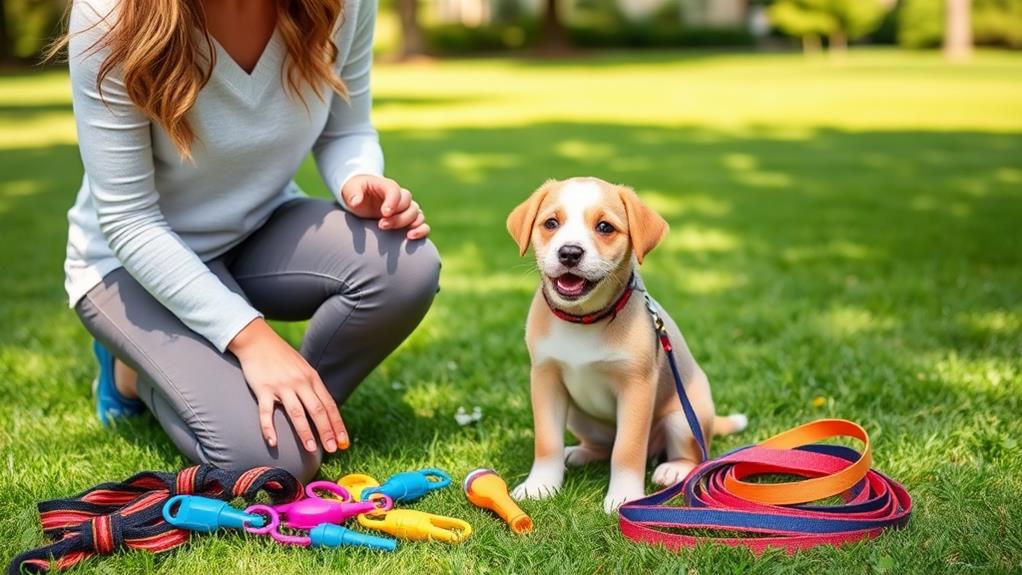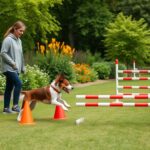To train your puppy for obedience, use positive reinforcement techniques like treats and praise to reward desired behaviors. Consistency is key, so use the same commands and guarantee everyone in your home is on the same page. Incorporate clicker training to mark good behaviors and gradually reduce treats as your puppy learns. Don't forget to socialize your pup with people and other dogs to foster good habits. Crate training provides a secure space, while leash training helps with walking manners. With patience and practice, you'll build a strong foundation. There's so much more you can explore to enhance your training journey!
Positive Reinforcement Strategies
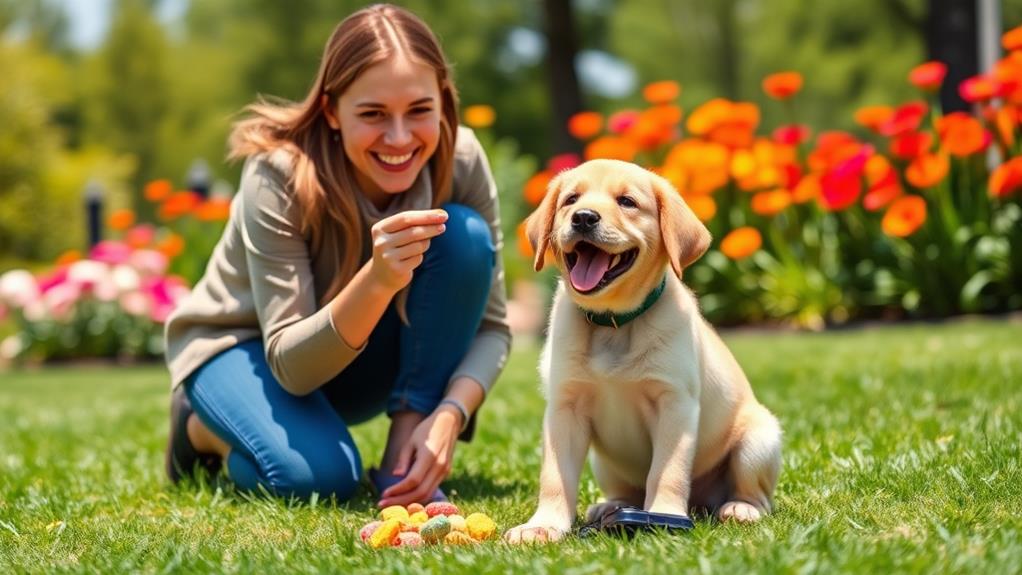
When you train your puppy, using positive reinforcement strategies is essential for building a solid foundation of obedience. This approach focuses on rewarding your puppy for desired behaviors rather than punishing them for mistakes. By using treats, praise, or playtime as rewards, you create a positive association with good behavior, which encourages your puppy to repeat those actions.
Start by identifying which behaviors you want to reinforce, like sitting or coming when called. When your puppy performs the desired action, immediately reward them. The timing of your reward is pivotal; it should happen within seconds of the behavior so your puppy clearly understands what they're being rewarded for.
Consistency is key. Make sure everyone in your household uses the same commands and rewards to avoid confusing your puppy. As your puppy learns, gradually phase out treats, replacing them with verbal praise or affection.
Clicker Training Essentials
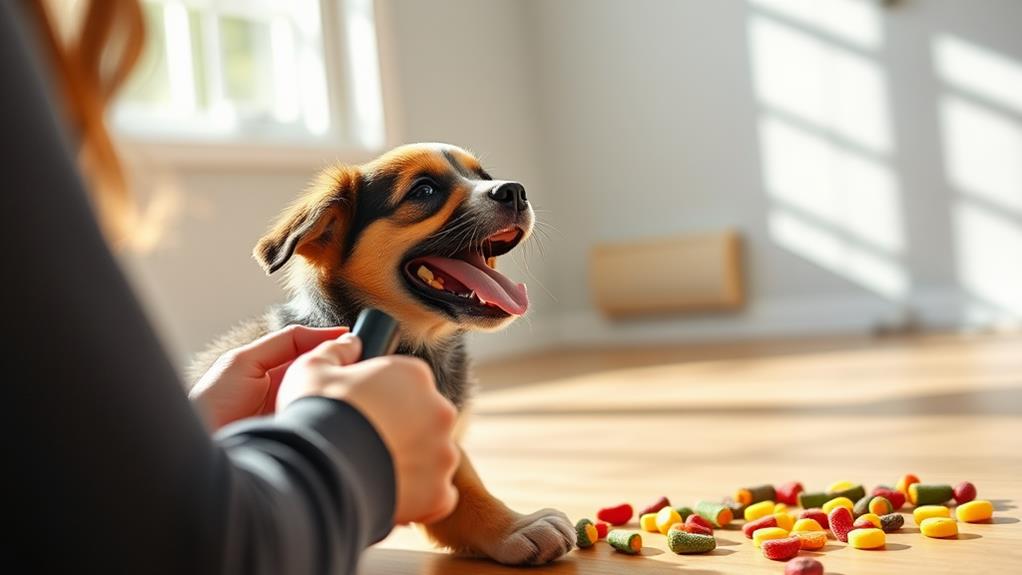
Clicker training is a powerful tool for instilling obedience in your puppy. This method uses a small handheld device that makes a distinct clicking sound to mark desired behaviors. When your puppy performs a behavior you want to encourage, like sitting or staying, you click the device immediately, followed by a reward, usually a treat. The click acts as a clear signal that your puppy did something right, making it easier for them to understand what you expect.
To get started, introduce the clicker to your puppy. Click and treat several times to create a positive association with the sound. Once your puppy understands that the click means a reward is coming, you can begin teaching commands. Be sure to click right at the moment your puppy executes the desired behavior to reinforce the connection.
Keep your sessions short and fun, ideally around five to ten minutes. This keeps your puppy engaged and keen to learn. As your puppy masters commands, gradually reduce treats while continuing to use the clicker for reinforcement. With consistent practice, you'll see your puppy responding with enthusiasm, making clicker training an essential part of your obedience toolkit.
Consistency in Commands
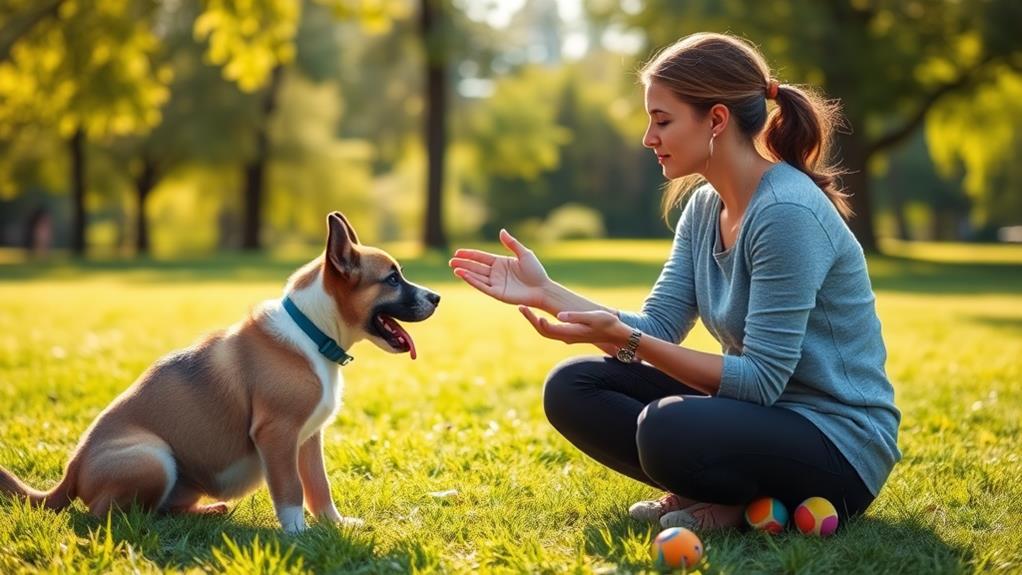
Consistency in commands is essential for effective puppy training. When you use the same words and gestures for commands, your puppy learns faster and understands what you expect. If you say "sit" one day and "down" the next, your puppy will get confused and may not respond as you want.
Make sure everyone in your household uses the same commands. If you've got multiple family members, it's vital that everyone is on the same page. Choose a set of commands and stick to them. This uniformity helps your puppy associate specific actions with the same cues.
Also, reinforce your commands with positive reinforcement. When your puppy responds correctly, reward them with treats or praise. This creates a strong connection between the command and the desired behavior, making it more likely your puppy will obey in the future.
Socialization Techniques
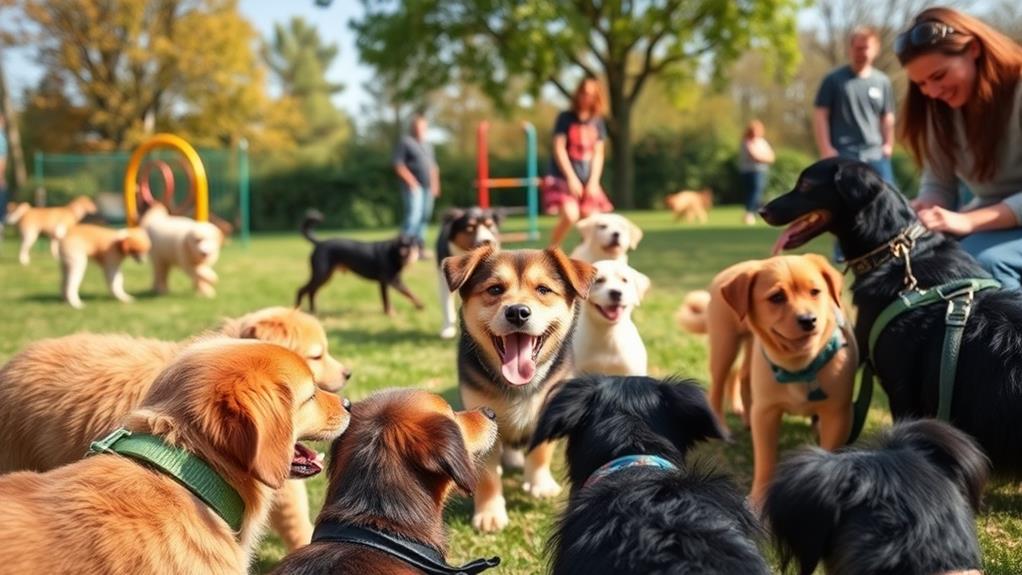
How can you guarantee your puppy grows into a well-adjusted adult dog? The answer lies in effective socialization techniques. Starting early helps your puppy learn how to interact positively with various people, pets, and environments.
Expose your puppy to different environments: Take them to parks, pet-friendly stores, and busy streets to help them adapt to various sights and sounds.
Introduce your puppy to a variety of people: Encourage friends and family to meet your puppy, allowing them to experience different ages, genders, and appearances.
Arrange playdates with other dogs: This helps your puppy learn proper dog behavior and develop confidence around their peers.
Enroll in a puppy socialization class: These classes provide structured interactions with other puppies, under the guidance of a professional trainer.
Crate Training Advantages

Recognizing the benefits of crate training can substantially enhance your puppy's development and your household's harmony. Crate training provides a safe and secure space for your puppy, helping them feel comfortable and reducing anxiety. When you introduce a crate, you create a den-like environment that taps into their natural instincts, making it a cozy retreat.
Another major advantage is housebreaking. Puppies generally avoid soiling their sleeping area, so using a crate effectively teaches them to hold it until they're outside. This method accelerates the housebreaking process and helps establish a routine.
Crate training also offers convenience when you need to leave your puppy alone. It prevents destructive behaviors by keeping them contained in a safe space while you're away. Plus, it can help with travel, making trips more manageable by providing your puppy with a familiar environment.
Furthermore, crate training can aid in managing your puppy's behavior during times of excitement or overstimulation. By giving them a quiet place to retreat, you can help them learn calmness. Overall, crate training is an invaluable tool for fostering a well-adjusted, obedient puppy.
Leash Training Tips
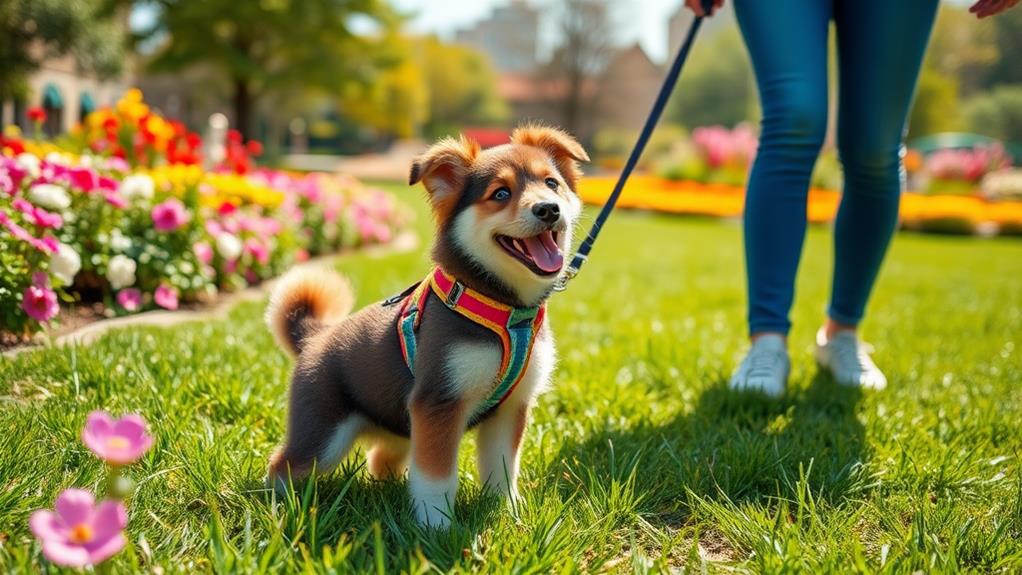
One key to successful leash training is starting early, ideally when your puppy is still a few months old. This sets the foundation for good walking habits and helps prevent bad behaviors down the line.
Choose the right leash and collar: Opt for a lightweight leash and a well-fitting collar or harness to guarantee comfort and control.
Use treats for motivation: Reward your puppy with treats when they walk nicely beside you. This positive reinforcement encourages good behavior.
Practice in a distraction-free environment: Start training in a quiet space, then gradually introduce distractions as your puppy becomes more confident.
Keep sessions short and fun: Puppies have short attention spans, so keep training sessions brief and engaging to maintain their interest.
Patience and Persistence
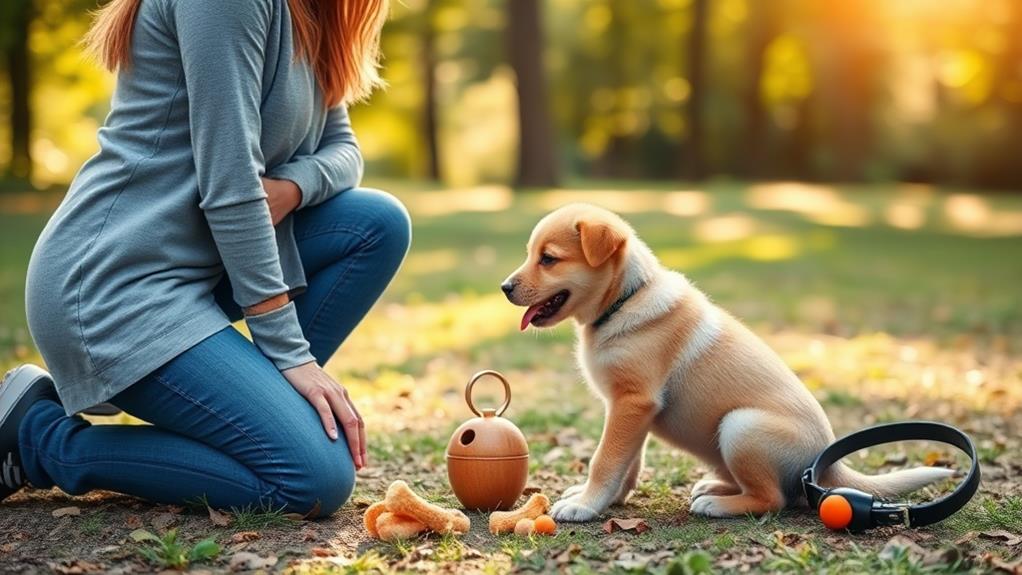
Successful leash training lays the groundwork for your puppy's obedience, but it requires patience and persistence to see lasting results. When you start training your puppy, don't expect instant perfection. Mistakes will happen, and that's okay. Embrace those moments as learning opportunities for both you and your pup.
Consistency is key. You'll need to practice daily, reinforcing commands and behaviors until they become second nature. If your puppy doesn't respond as you hope, take a step back. Adjust your approach rather than getting frustrated. This could mean changing your rewards or taking a break to refocus.
Remember, every puppy learns at their own pace. Some may grasp commands quickly, while others might take weeks or even months. Celebrate small victories along the way, whether it's a successful walk without pulling or a perfect sit. These moments build your confidence and bond with your puppy.
In the end, your patience and persistence will pay off. Your puppy won't only become more obedient but will also trust and rely on you as a leader. Stick with it, and you'll create a strong foundation for a well-behaved dog.
Frequently Asked Questions
What Age Is Best to Start Puppy Training?
You should start puppy training as early as eight weeks old. This age allows your pup to absorb lessons quickly, building a strong foundation for good behavior. Early training sets the stage for a well-mannered dog.
How Long Should Training Sessions Last?
Think of training sessions as seeds in a garden. You'll want to nurture them, yet keep them short—about 5 to 10 minutes. This way, your puppy's attention flourishes, making learning enjoyable for both of you.
Can I Train Multiple Puppies at Once?
You can train multiple puppies at once, but it's challenging. They might distract each other, making focus difficult. Start with shorter sessions and gradually increase their duration as they learn to concentrate better together.
What Are Common Mistakes to Avoid in Puppy Training?
When training your puppy, avoid common mistakes like inconsistency, using harsh corrections, and lacking patience. Focus on positive reinforcement, setting realistic expectations, and ensuring regular practice to foster a strong bond and effective learning.
How Do I Choose the Right Trainer for My Puppy?
When selecting a trainer, picture a gardener nurturing a young plant. Look for experience, positive reviews, and a training style that resonates with you. Trust your instincts; a good match will help your puppy flourish.
Conclusion
Ultimately, using effective puppy training techniques can set the foundation for a well-behaved dog. Did you know that puppies trained with positive reinforcement learn commands up to 50% faster than those trained with punishment? By incorporating strategies like clicker training, consistent commands, and socialization, you'll not only enhance your pup's obedience but also strengthen your bond. Remember, patience and persistence are key—enjoy the journey of training your furry friend!

